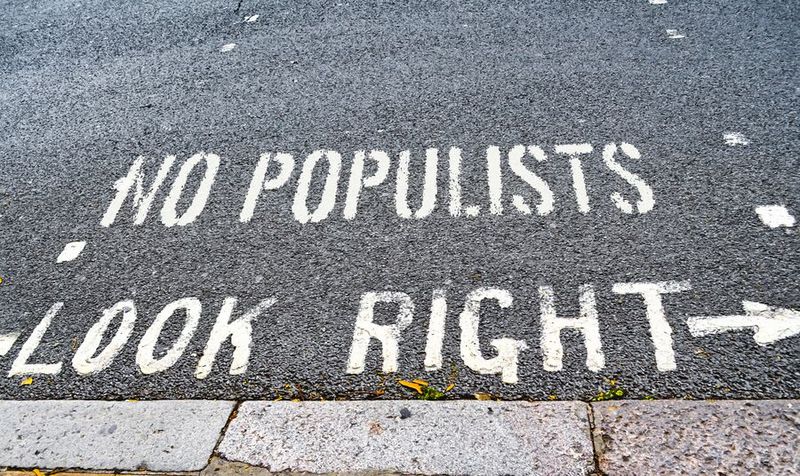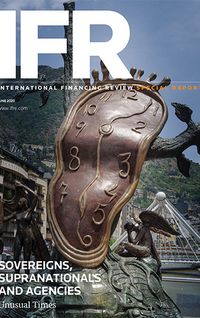As the coronavirus pandemic swept relentlessly across the world from China to Europe and then on to the US, the leaders of Latin America’s two largest economies remained in denial about the threat even as the deadly virus marched ever closer.
In Brazil, populist far-right president Jair Bolsonaro dismissed Covid-19 as media ‘hysteria’ and just ‘a little flu’, while Mexico’s leftist president Andres Manuel Lopez Obrador initially downplayed the risks, urging Mexicans to continue embracing each other and eating out at restaurants. As recently as mid-March, he was still attending political rallies and hugging and kissing supporters.
At a news conference a few days later, he took out his wallet and showed off the religious amulets that he claims will shield him from the virus. It was not until later in March that Mexico started taking the pandemic more seriously, imposing social distancing measures, banning large gatherings and ordering non-essential businesses to close.
In Brazil, however, Bolsonaro has continued to resist calls for stricter lockdown measures, forcing state governors to take matters into their own hands. Sao Paulo governor Joao Doria, for instance, ordered a statewide shutdown of non-essential businesses in late March.
Political infighting within Bolsonaro’s own cabinet has also hampered efforts to tackle the pandemic. His justice minister and anti-corruption figurehead Sergio Moro resigned in April, accusing Bolsonaro of political interference. And by mid-May he had also lost two health ministers: Luiz Henrique Mandetta, who was sacked after advising people to stay indoors and follow social distancing guidelines, and Nelson Teich, who quit after just four weeks in the job.
By neglecting public health and putting the economy first, Bolsonaro has “made the wrong gamble,” said Jan Dehn, head of research at emerging markets asset manager Ashmore.
“That has put him in the same camp as Russia, Britain and the US, and all of those countries have one thing in common - they are all right-wing populist governments,” Dehn said. “All of those countries opted initially not to engage in full-blown lockdowns, and that was really a question of values: do I want good economic performance or do I want to protect individuals? That was the choice, and it’s backfired for Bolsonaro.”
By mid-May, there were almost 17,000 coronavirus-related deaths in Brazil, putting it behind only the US, the UK, Italy, Spain and France. In Mexico, where testing is the lowest among OECD countries, Covid-related deaths stood at roughly 5,000.
The economic response has also been mixed. While Brazil has ramped up spending in an attempt to cushion the blow, Lopez Obrador has refused to relax his fiscal thriftiness - a decision that economists reckon will cause an even sharper slowdown.
We see a 9% contraction of GDP this year and that has a downward bias, so it could be even worse,” said Ernesto Revilla, chief Latin America economist at Citigroup. “The government has done very little to smooth out the shock, if you look at both monetary and fiscal policy, both are still tight when they should be stimulative.
Mexico’s central bank cut its policy rate by 50bp to 5.5% on May 14 but remains relatively hawkish compared to other rate-setters in the region. Brazil, by contrast, slashed its interest rate by 75bp to 3% in early May, a larger pruning than many market-watchers expected.
In terms of fiscal policy, the comparison with other emerging markets is even more dramatic because the [Mexican] government has opposed any support to the private sector,” Revilla said. “The government says it doesn’t want to bail out the private sector but paradoxically that would make for a deeper downturn that would be harder to get out of.”
Even bond investors, who usually break into cold sweats at the merest hint of fiscal loosening, are perplexed by the relative inaction.
“It’s a bit difficult to understand the reasons; they decided to stay on the fiscal prudence side which is probably not the right decision,” said Viktor Szabo, investment director at Aberdeen Standard Investments. “The risk of a permanent destruction of capacity is much higher from this pandemic, so governments do need to step in and help the economy stay afloat. With Mexico, we don’t really see where the policy is heading - it’s a bit like putting your head in the sand as if nothing is happening.”
Yet Brazil’s decision to increase spending to prop up the economy while the coronavirus rips through the population is also causing alarm among some investors, given its already stretched fiscal metrics.
If [the pandemic] is more prolonged than we anticipate, those governments that have gone a bit overboard in terms of fiscal expansion could end up in trouble and rating agencies would probably be concerned about that,” said Anders Faergemann, an emerging markets fund manager at PineBridge Investments. “We do have some concerns about Brazil and their ‘war budget’, so while Mexico will be harder hit in terms of its immediate growth impact than Brazil, we believe over a medium-term horizon Mexico will come out better from this.”
Other investors say their allocation decisions are not being based solely on a country’s response to the pandemic - economic or otherwise - but more on how that response will translate into growth once the crisis eases.
The response to the pandemic is quite important and does factor highly in the process because it does impact the economics and the ability for the country to grow, however there is no real one size fits all, countries have different responses, so we’re not trying to judge the response per se but more the potential impact on future growth prospects,” said Hemant Baijal, head of multi-sector portfolio management for global debt at Invesco.
LOCAL HEROES
Baijal said the impact of the coronavirus in Latin America is not only going to be uneven across countries but also in markets - local currency bonds, for instance, are likely to perform better than hard currency debt.
Take Mexico. Its US dollar bonds maturing in 2030 were trading at a spread of almost 300bp over Treasuries on May 20, around 165bp wider than early January, according to Refinitiv data. By contrast, Mexico’s 10-year peso bonds were trading at 6.13% on May 20, roughly 75bp lower than in January.
Part of the reason that domestic bonds have been able to shrug off the stress that has shaken hard currency debt is because local markets are much deeper than they were a decade ago, with foreign investors owning a far smaller share of the bonds.
Not having a lot of foreign investors in your market is a blessing because it’s precisely the behaviour of foreigners, this inane desire to sell everything you own in EM every time you get scared, that leads to the convolutions and the volatility in the market,” said Dehn.
This crisis has clearly demonstrated the importance of developing domestic bond markets, and it’s really on display in Latin America because of the dramatic contrasts between countries that have domestic markets and those like Ecuador and Argentina that rely on external markets and who are in severe financial distress.”
Another reason that local currency debt is more stable now than in the past is that inflation is under control in most Latin American economies, said Claudio Irigoyen, head of LatAm research at Bank of America.
That’s important because most of the countries let their currencies depreciate and absorb the shock through depreciation, [central banks] didn’t have to hike interest rates to defend their currencies to avoid the pass through to inflation, so that was a significant positive to deal with the shock - many emerging market central banks were actually able to cut interest rates to deal with this,” he said.
That is one explanation why some fixed income investors are more bullish about Mexico despite the question marks over its handling of the crisis.
“There are concerns in Mexico around the leadership, but we do think that as a starting point it is in a much better position than most Latin American economies in the sense that the central bank has much more room to cut interest rates,” said Faergemann.
Yet while Latin America was one of the last regions to be impacted by the coronavirus pandemic, it is also likely to be one of the worst hit. For starters, sovereign downgrades have been piling up. Since March, Latin America is tied with sub-Saharan Africa with the highest number of credit rating cuts, according to Fitch Ratings. And in April, the IMF ratcheted down the region’s growth forecast for the remainder of the year, predicting a contraction of 5.2%, having previously projected an expansion of 1.6%. Economists expect that number to be revised even lower once the extent of the damage becomes clearer.
Latin America is the weakest link within emerging markets because this is a dual shock,” said Irigoyen. “Even if the pandemic impacted the whole world other than Latin America, that is already a negative shock for LatAm. So on top of that you have the pandemic spreading through the region, and on top of that you had a drop in commodity prices, especially the price of oil, which was very detrimental for countries like Mexico, Colombia and Ecuador. So when you put everything together, LatAm is the most impacted region in the world.”
To see the digital version of this report, please click here
To purchase printed copies or a PDF of this report, please email gloria.balbastro@refinitiv.com




























